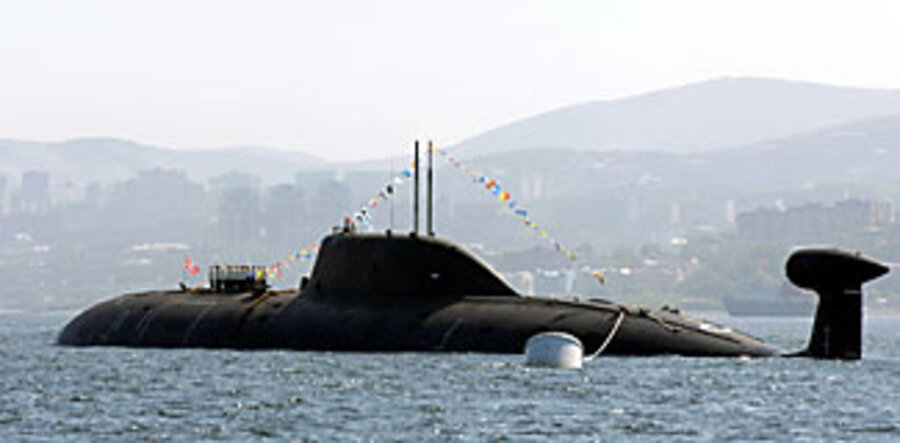Russian sub accident points to Navy's shortcomings
| Moscow
An accident aboard a Russian nuclear attack submarine that killed at least 20 and injured 22 late Saturday, is the latest in a series of undersea tragedies that have struck the Russian Navy as it struggles to regain Soviet-era capacities.
The ship's nuclear reactor was undamaged in the incident, and survivors evacuated to the naval base at Vladivostok on Sunday, Russian officials said.
"During sea trials of a nuclear-powered submarine of the Pacific Fleet the firefighting system went off unsanctioned, killing over 20 people, including servicemen and workers," Russian naval spokesman Cpt. Igor Dyagalo told journalists.
"The submarine is not damaged, its reactor works as normal, and background radiation levels are normal," he added.
The malfunction of the firefighting system, which spewed deadly freon gas through the forward compartments of K-152 Nerpa, an Akula-II class attack sub undergoing diving trials in the Sea of Japan, has a little-known international twist. Though neither government has officially admitted it, both Indian and Russian media have been reporting for months that the 12,000-ton Nerpa was to be handed over to the Indian Navy early next year under a 10-year lease.
The acquisition would multiply India's military capabilities in the sensitive Indian Ocean, and raise questions about Russia's role in proliferating nuclear technologies. Indian news agencies reported last week that a team of 40 Indian naval specialists was slated to arrive later this month in Vladivostok to learn about the ship.
"India was one of the main supporters of Russia's defense industries after the Soviet Union collapsed, and provided funds that helped to keep our aviation and shipbuilding going," says Vadim Kozulin, a military expert with the PIR Center, a security think tank in Moscow. "It's only been in the past three years that Russian military procurement budgets have been greater than the earnings from exports."
According to media reports, the deal was struck in 2004 in which India paid up to $650 million to refit the Admiral Gorshkov, a Soviet-era aircraft carrier, and assist completion of the Nerpa, which had lain on blocks at the Komsomolsk-na-Amur shipyard since its construction was largely abandoned in 1991.
The Akula-II class of nuclear subs, a late Soviet-era design, are able to dive deeper, more than 600 meters, run more silently than previous attack subs, and move at speeds up to 33 knots while fully submerged.
The Nerpa will not be equipped with the Akula class sub's standard complement of long-range cruise missiles, due to international strictures on proliferation of missile technology, says Pavel Felgenhauer, military expert with the independent Novaya Gazeta newspaper in Moscow. But Indian media have reported that the Indian Navy may install indigenous nuclear-capable missiles, and use its operational experience with the Nerpa to help develop Indian-built nuclear-powered subs.
The Nerpa's patchwork history may have contributed to Saturday's disaster. "They are using bits of Soviet equipment and hardware, brushing off the rust and putting in new stuff," says Mr. Felgenhauer. "That's just not a good way to develop operational equipment."
Moreover, Russia's military establishment has a crushing shortage of qualified experts. "That submarine was being constructed over a period of 15 years, and was the only one being built at the Amur shipyard during that time," says Alexander Goltz, a military expert with the online newspaper Yezhednevnaya Gazeta. "How many of the original specialists and skilled workers would have stayed on during that period? Very few. Everything conspired to make that ship very vulnerable."
Captain Dyagalo said that 208 people were aboard the Nerpa at the time, including 81 servicemen plus naval technicians and workers from the Komsomolsk-na-Amur shipyard. Fourteen civilians were among the dead, he said.
Initial reports indicated that the accident resulted from a malfunction of the Aqueous Film Forming Foam (AFFF) system, which is used to quickly suffocate a major fire with a stream of a freon mixture. The foam is only supposed to be released when a submarine compartment is engulfed in flames. Any contact with it will kill an unprotected person instantly.
"[The Nerpa incident] is a completely abnormal kind of accident, not the sort of thing that's ever supposed to happen aboard a submarine," says Mr. Goltz.
Russia's worst-ever submarine disaster occurred in August 2000, when the nuclear-powered Kursk sank in the Barents Sea, killing all 118 crew members.
Three years later, a decommissioned nuclear sub, the K-159, sank in the Barents Sea, killing nine members of the skeleton crew aboard at the time. And in 2005, a minisubmarine of the Pacific Fleet got trapped in an undersea fishing net near Vladivostok, and was saved with the help of a British rescue team.





